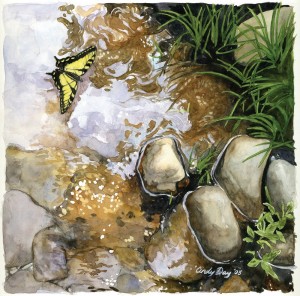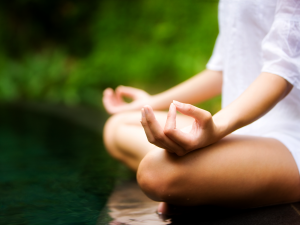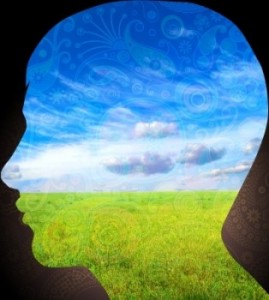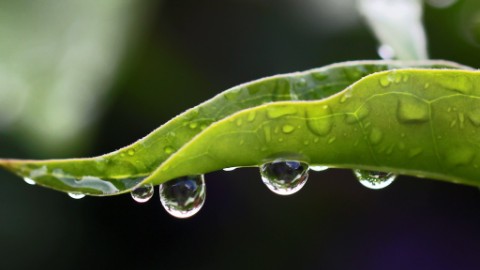It’s a lazy summer afternoon, and at the only sandy ‘beach’ in Lower Park, a big group of parents and children frolic in the water.
 At One-mile, where the creek has been dammed for decades to create a huge public swimming pool some 200 meters long and 50 meters wide, there are more people in the water and on the grass than I’ve ever seen.
At One-mile, where the creek has been dammed for decades to create a huge public swimming pool some 200 meters long and 50 meters wide, there are more people in the water and on the grass than I’ve ever seen.
Though the sun beats down relentlessly during hottest part of the day, it’s tolerable in the shade beside the stream. Butterflies flit over the creek, and birds land on the rocks at mid-stream.
It takes the better part of an hour for meditation to ignite. After a few days of difficulty and distress, the body itself yearns for rebalancing and renewal.
During sittings in nature there is no goal. But there is intent—to observe without the observer and thereby allow the mind to grow quiet, and the heart to grow peaceful and clear.
Describing meditation is inherently a cognitive exercise, and rather a contradiction, since it’s not an intellectual process at all, and there’s no means by which the mind-as-thought can awaken it. Hopefully my writing about it is more of a paradox, and the reader can see beyond the contradiction that using words to describe a wordless process imposes.
So what is meditation? Why does one usually require nature to awaken it? Perhaps others don’t require the mirror of nature, but I’m sure that ‘group meditation’ is an oxymoron, and that techniques and methods are inimical to effortlessly initiating a state of negation.
The mind-as-thought mediates experience with symbols. Then words, images and memories—the residue of experience—pile up in the mind and heart, clouding perception and corrupting feeling.
As we get older, the accretion of experience—all the hurts, sorrows, unresolved conflicts, and unnecessary  memories—grow and slowly shrink the space of the mind and heart. These accretions, probably more than poor diet, also affect the body, making it insensitive to beauty, and to ugliness.
memories—grow and slowly shrink the space of the mind and heart. These accretions, probably more than poor diet, also affect the body, making it insensitive to beauty, and to ugliness.
Therefore, understanding and applying the art of meditation on a daily basis is even more important than other health maintenance practices. Indeed, in one sense, methodless meditation is inner hygiene.
However, since any form of effort prevents the meditative state from happening, what can one do at all?
One can make and take the time to do the most radical thing in this society—nothing. Simply set everything aside for a little while every day, and observe, preferably in nature, even if it’s one’s backyard, porch, or balcony.
Nature and sound are the best mirror. If one sits and is passively aware in a relatively quiet place where one isn’t likely to be disturbed, the senses soon become attuned to one’s surroundings. Then, by allowing the same inclusive, undirected awareness to turn within, one is able to watch thoughts and emotions as they arise—without judgment or interference—which means, without the watcher.
It’s more difficult to meditate in a city, but one can still do so, aided by the changing light at the beginning or ending of the day perhaps. Don’t focus on your breath and all that other nonsense; just listen and watch, outwardly and inwardly. Let the thoughts and emotions that arise come fully to the fore with attention and without interference, or even naming; in doing so, they tell their story and fall silent.
The ensuing state of negation in meditation is the highest action of which a human being is capable, and it has nothing to do with discipline. That word, discipline, normally means to force oneself to do something for the sake of something else–a rough means to reach an exalted end.
 But the root meaning of the word discipline is a far cry from its usual first and second definition: “Punishment;’ or, ‘training to act in accordance with rules.” At bottom, discipline simply means: “learning, from the Latin, discipulus—pupil.”
But the root meaning of the word discipline is a far cry from its usual first and second definition: “Punishment;’ or, ‘training to act in accordance with rules.” At bottom, discipline simply means: “learning, from the Latin, discipulus—pupil.”
Having negated the observer in passive observation, which grows quicker than thought’s habit of dividing itself from itself, one sees that thought/emotion is actually a single stream. In attending to the stream without division or effort, the pollution of the past within us flows by, and mind and heart grow quiet and clean again. The river cleans itself when it’s allowed to flow freely.
Outwardly, it’s not difficult to observe the toxic effluents of many minds, though in individualistic cultures each person is viewed as a world unto themselves. We see collective ignorance manifest in the world every day on the news, and feel its effects within us, beyond the problems of our personal lives, if we are at all aware of ourselves and others.
That’s why space and stillness of mind is the most important thing. Without that, there’s only the chatter and superficiality of thought, caught in the muddy current of man.
The deepest intent of the human being is liberation. But life, as most people know it, is a series of thoughts and experiences strung together in an unbroken chain. Resigning to that way of living utterly prevents freedom, and eventually sinks us into the muck of the human past.
However briefly, one spontaneously (and always unexpectedly) leaves the polluted stream of content-consciousness when passive awareness gathers sufficient attention, and thought falls silent.
Duality does not exist in nature, only in the human mind. Anyone who has sat silently alone under an open sky as the sun slides below the horizon and dusk descends can attest that life is a seamless movement. But lacking insight, the evolutionary gift of symbolic thought has made the world into a divided, dualistic and desolate place.
Even so, as the poet Gerard Manley Hopkins wrote, “And for all this, nature is never spent; there lives the dearest freshness deep down things.”
Martin LeFevre

